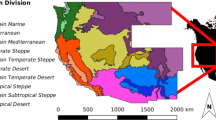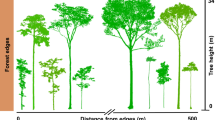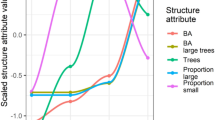Abstract
In tropical forests, large canopy and emergent trees are crucial sources of fruits, flowers and shelter for animal populations1,2. They are also reproductively dominant2 and strongly influence forest structure, composition, gap dynamics, hydrology2 and carbon storage3. Here we show that forest fragmentation in central Amazonia is having a disproportionately severe effect on large trees, the loss of which will have major impacts on the rainforest ecosystem.
Similar content being viewed by others
Main
Our study area is a 1,000-km2, experimentally fragmented landscape near Manaus, Brazil. More than 64,000 trees of about 1,300 species (with stem diameters larger than 10 cm, measured at 1.3 m height or above any buttresses) were studied in 31 permanent 1-hectare plots in continuous forest, and 38 plots in nine forest fragments ranging from 1 to 100 ha in area.
Starting before fragment isolation in the 1980s, we checked each plot five to eight times over periods of up to 20 years (mean, 14.7 years), during which counts and diameter measurements were recorded for all living and dead trees4,5.
Before fragmentation, there was no significant difference between fragmented and continuous plots in the density of total trees or large (over 60 cm in diameter) trees (P>0.17, Mann–Whitney U-tests). Large trees comprised only 1.8% of all trees, but nearly a quarter (23.4%) of estimated above-ground forest biomass (W.F.L., unpublished data).
Plots were divided into edge (plot centre less than 300 m from the nearest forest edge) and interior (further than 300 m from the edge) categories, because it has been shown that increased tree mortality is detectable at up to 300 m from forest edges4. A total of 6,348 trees died in the edge plots, whereas 3,523 died in the interior plots; annualized rates of mortality (calculated using a logarithmic model4) were about twice as high near edges (2.49±1.50% yr−1) as they were in interiors (1.23±0.43% yr−1).
Not only did many more trees die near forest edges, but a higher proportion of the dying trees were large. When the size-distributions of dead trees were compared between edge and interior plots, there were nearly equal proportions of small and medium-sized trees (under 60 cm diameter). For large trees, however, there was an almost 40% increase in mortality over that expected near edges — a significant difference (P = 0.036, d.f. = 1, G = 4.38; G-test). The net result is that large trees died at a rate nearly three times faster (281%) when they were within 300 m of edges than they did in forest interiors (Fig. 1). Furthermore, these findings may be conservative because several of our fragments are now surrounded by regrowth forest and all are protected from logging and major wildfires, factors that limit tree mortality6,7.
Calculated as: [(mean mortality rate on edges – mean mortality rate in interiors)/mean mortality rate in interiors] × 100. Sample sizes of dead trees are as follows. 10–15 cm diameter: 2,740 (edge); 1,501 (interior). 15.1–20 cm diameter: 1,308 (edge); 745 (interior). 20.1–30 cm diameter: 1,219 (edge); 684 (interior). 30.1–59.9 cm diameter: 944 (edge); 538 (interior). >60 cm diameter: 137 (edge); 55 (interior).
There are at least three reasons why large trees are unusually vulnerable in fragmented rainforests. First, because of their tall stature and relatively thick, inflexible trunks, large trees may be especially prone to uprooting and breakage near forest edges, where wind turbulence is increased4. Second, lianas (woody vines) — important structural parasites that reduce tree survival8 — increase markedly near edges9 and large, old trees are particularly susceptible to liana infestation8. Third, because their crowns are exposed to intense sunlight and evaporation, large tropical trees are sensitive to droughts1,10 and so may be vulnerable to increased desiccation11 near edges.
In fragmented rainforests of the Amazon (Fig. 2), the rapid rate of mortality of large trees may markedly reduce the fecundity of canopy and emergent species2, diminish forest volume and structural complexity, promote the proliferation of short-lived pioneer species4, and alter biogeochemical cycles affecting evapotranspiration2, carbon cycling3 and greenhouse-gas emissions5. Equally alarming is the possibility that, because tree mortality is chronically increased in forest fragments4 and large trees range in age from a century to well over 1,000 years old3,10,12, their populations in fragmented landscapes may never recover.
References
Leighton, M. & Wirawan, N. in Tropical Rain Forests and the World Atmosphere (ed. Prance, G.) 75–102 (AAAS Symposium 10, Boulder, 1986).
Richards, P. W. The Tropical Rain Forest (Cambridge Univ. Press, 1998 ).
Clark, D. B. & Clark, D. A. Forest Ecol. Manage. 80, 235–244 (1995).
Laurance, W. F. et al. Ecology 79, 2032–2040 (1998).
Laurance, W. F. et al. Science 278, 1117– 1118 (1997).
Mesquita, R., Delamônica, P. & Laurance, W. F. Biol. Conserv. 91, 129– 134 (1999).
Nepstad, D. C. et al. Nature 398, 505–508 (1999).
Putz, F. E. Ecology 65, 1713–1724 ( 1984).
Laurance, W. F. et al. Science 282, 1611a ( 1998).
Condit, R., Hubbell, S. P. & Foster, R. B. Ecol. Monogr. 65, 419– 439 (1995).
Kapos, V. J. Trop. Ecol. 5, 173–185 ( 1989).
Chambers, J. Q. et al. Nature 391, 135–136 (1998).
Author information
Authors and Affiliations
Corresponding author
Rights and permissions
About this article
Cite this article
Laurance, W., Delamônica, P., Laurance, S. et al. Rainforest fragmentation kills big trees. Nature 404, 836 (2000). https://doi.org/10.1038/35009032
Issue Date:
DOI: https://doi.org/10.1038/35009032
This article is cited by
-
The landscape scale of effect on the alpha and beta diversities of woody species in a semideciduous tropical forest
Landscape Ecology (2024)
-
Edge effects on tree architecture exacerbate biomass loss of fragmented Amazonian forests
Nature Communications (2023)
-
Flextime: Black-and-White Ruffed Lemurs (Varecia variegata) use Opposing Strategies to Counter Resource Scarcity in Fragmented Habitats
International Journal of Primatology (2023)
-
Forest fragmentation and its associated edge-effects reduce tree species diversity, size, and structural diversity in Madagascar’s transitional forests
Biodiversity and Conservation (2023)
-
Ecological correlates of giant squirrel (Ratufa bicolor) microhabitat use in a lowland tropical forest: implications for matrix management
Mammalian Biology (2023)
Comments
By submitting a comment you agree to abide by our Terms and Community Guidelines. If you find something abusive or that does not comply with our terms or guidelines please flag it as inappropriate.





